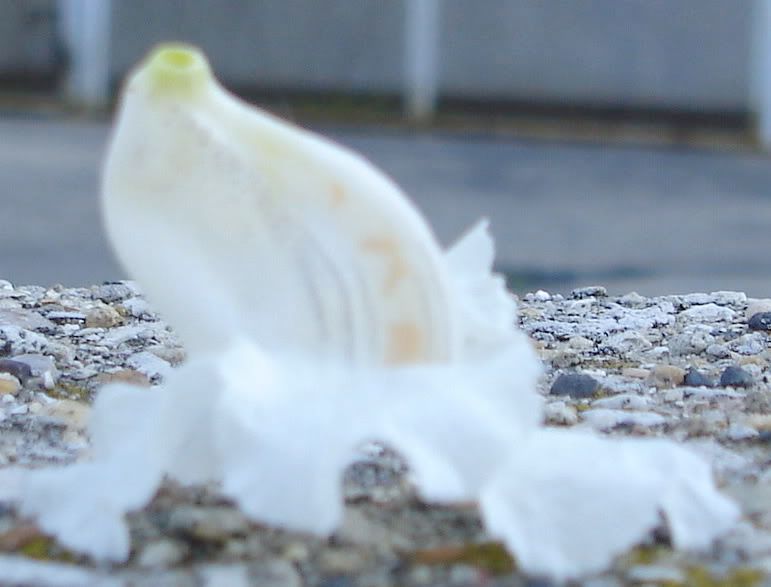I originally wrote this on an old MySpace Blog 12 June 2007 at 10:45 P.M.
I wanted to rescue it since I really don’t use the MySpace page anymore.
It’s Putalca Time!
Current mood: contemplative
contemplative
Putalca. I always think of the word the first or second week of June.
I had a friend in high school named Marc, who was dyslexic and a little backwards. We would play cards with Marc and his wife when we got off work at the Burger King. I guess you could say that it was strange my friend Kristie and I were hanging around a 40-some-odd year old couple when we were 16 and 17, drinking beer, and playing cards in the side yard until three or four in the morning. But it was something different from the faux-goth angst I dealt with at school, and a whole lot more interesting in terms of life experience.
I did not sit down tonight to write about my relationship with Marc and Judy. In their side yard there was a large tree – one of my favorite trees – a Catalpa. Catalpas are a favorite of mine for a number of reasons.
Functionally, they are the perfect wood for fence-posts and damp areas. The wood is dense and has a green cast. Because the live trees can take a lot of abuse, they are also good for tree houses. Once the tree is cut, the wood is difficult to split and does not work very well for lumber or firewood. This was good for me, as I had a special affinity for them. More on that later.
Aesthetically, they are a kind of strange and knobby tree.
They remind me, in the fall and winter, of strange and burdened old men. Crooked and worn, they are easy to pick out of the dormant woods. In the spring and summer they remind me of an old man in love. The leaves come on fast. They are large and heart shaped and have a heft to them. The first week in June, they start to bloom cascades of creamy white flowers spotted with orange and brown that smell sweetly and fall from the tree. By the second week in June, they are well in bloom, and the smell of the flowers can carry for yards and yards.
My particular affection for the catalpa tree developed around age seven or so. I had always known what they were thanks to a forestry program in which so many of the kids in the country were enrolled. They were also used as plantings along property lines and in cemeteries, so they were very common in the near-south, where I grew up. We had two of them on each side of our sandbox.
These two catalpas were planted around the civil war and used to mark a large gate that connected the barnyard to pasture. By the time Dad built the sandbox, the pasture was long grown over and the barnyard had become our side yard. But there stood these strange trees. Our sandbox was a large 16 foot square made of 2x12s that Dad had filled with two tons of sand. We did not have a TV at the time, so I spent a lot of time in the sandbox over the next five years letting my imagination go. These trees helped.
I should mention that we did not have a TV because we had no electricity. Mom would play a battery operated radio in the kitchen, but if one wanted control over their music, the only option was a wind-up Victrola in the living room. That Victrola informed and fueled my fantasy life in the sandbox.
For those who may not know, a Victrola is a record player that plays the old 78 rpm standard records. You wind it up, put the record on, and then lower the needle onto the grooves. When you release the clutch under the spinner, the record starts to spin and sound is vibrated through a series of baffles in the front of the case. There is no electricity involved, and the longest record you can play is – maybe – 10 minutes. This is labor-intensive aural enjoyment for sure. By the 40′s they were for the most part obsolete in all but the most remote areas. Most everyone had switched to electric phonographs by the 30′s and 40′s.
Because they were out of favor early-mid century, there was not a whole lot of selection as far as music was concerned. While my friends were listening to what we would now call “the best of the 80′s” pour from their parent’s radios and cassette players, I was content with Operas staged in the teens and 20′s, JaZZ recorded in Chicago, traditional German hurdy-gurdy oom-pah-pah, and blues from Mississippi.
One of my favorite Operas was “La Traviata”. I understood it. The other was “Lucia di Lammermoor”. But these particular versions were special. I am probably one of the only people in my peer group who has heard Lily Pons sing. The scene that was the most powerful for me was the “Mad Scene” in “Lucia…..”. Here, even if you do not know what she is singing, you just feel that her life is crumbling and she is losing her mind as well as her body as she is getting ready to kill her husband. The part is written for a very dynamic soprano and its power was enough to bring me to my knees. I was eight or nine.
Well. I was still a little kid in the middle of nowhere and needed something to do, so I began to incorporate these operas in the sandbox. While my brothers played baseball, (which I refused to play) I staged elaborate operas in the sandbox. On the south side was the stage – the proscenium framed out with twigs and pieces of rags. The audience sat in very graciously sloped stadium seating and an old wooden ammunition box was propped up over the audience for the more respectable and genteel members of society who had the taste and good fortune to purchase private box seats.
Unfortunately, my audiences were very lean most of the spring and summer – except the first two weeks of June. These were my prime attendance weeks. All of the ladies would come out in their finest dresses.
La Traviata and Lucia di Lammermoor would play to standing room only crowds. Almost all of those in attendance would be women. And, even though they were all wearing very similar garb, they were secure in that they were very, very elegant.
I think the gentlemen who were in attendance at these performances resembled popsicle sticks or clothespins. Probably the latter, as the clothesline was next to the sandbox.
One day, as Lucia was just getting ready to murder her bridegroom, my father decided he had had enough. I should be playing baseball and not “Lost in my own world” (his words). I ignored him when he asked me to join him and my brothers, I avoided him when he told me to join them, and I forgot that he wanted me to play ball when he outright demanded it. So Lucia was getting into her highest notes when my father started toward me. My back was to him, so I did not see it coming. Lily (who was playing the part of Lucia – duh) must have been frightened to death. She could see him coming, and yet she kept climbing the register. Up and up she went, higher and higher, when – throughout the audience – there was muffled shock as someone was yelling “WHEN I TELL YOU TO DO SOMETHING IT BETTER HAPPEN MR DO YOU THINK I AM KIDDING I AM TIRED OF YOU WITH YOUR HEAD IN YOUR OWN LITTLE WORLD OR UP YOUR BUTT AND YOU ARE GOING TO PLAY BALL WITH YOUR BROTHERS”
Imagine the audience’s shock and horror as my father stomped them all into the sand as he jumped over my shoulders. In my head, stages were crashing as the gilded columns fell into the orchestra pit. Women were running every which way as their lacy petticoats were torn from their gowns. Men were driven, feet first, into the floor of the opera house. And there I stood. Unable to do anything about it.
I did end up playing ball that day – all the while thinking about the carnage in the sandbox. I don’t think I ever staged another opera at that particular venue. It was deemed too dangerous. The foundations must have been bad. We moved a few of the performances to the more secluded venues near the lake, and eventually the troop disbanded. Or I grew up a little.
I am not sure what made me first think that Catalpa flowers looked like Victorian ladies when they are inverted, but to this day I look forward to the first two weeks or June. I am very lucky that there are Catalpas in Chicago. I go to the park and eat lunch around them, let them fall on me, and before I leave I always remember to set up a few of them as if they were having a small get-together. Theatre troop veterans having a laugh at tragedy they escaped from that tense afternoon in June sometime around 1983.



p.s. Still HATE baseball.
Since this is your most recent entry, and I was informed that if I read the blog, I had to comment on it, I will put my thoughts here. I haven’t read everything, but I can’t tell you how honored I am that you have shared this with me. I promise to respect your wishes about sharing it; although, I think it is beautifully written and SHOULD be shared.
It brought to mind this episode in my own life.
While you were building opera houses in your sandbox, I was similarly producing plays it the basement theatre on Orchard Lane. It was a ragtag affair, and I was usually reduced to playing all the parts, designing the sets, making the costumes and running the box office; which, considering most of our audience was comprised of mute stuffed animals with no money, was hardly that much of a strain.
We had a rather wide repertory at the Basement Playhouse, but most of the plays involved a sick, or dying heroine, and her sudden redemption at the last moment. There were almost always supernatural characters involved. Ghosts, fairies, goblins, and witches made regular appearances and were often the focus of minor and major sub-plots. Entrances made by flying were a favorite!
Opera was not unknown to us, and we made several attempts at presenting it, but we felt somewhat stymied by the fact that we had heard that all good Opera was in a foreign language (at least the ones we saw on PBS) and our language skills, though certainly precocious, hadn’t reached that level. The fact that no one could write music never seemed to be important however! Our most successful production was of Humperdink’s HANSEL AND GRETEL which was made possible by the aqusition of an English language recording for ‘young people’ that we lipsynced to while it played on a winnie the pooh record player. I played the witch, while two of my dolls, Abigail and Joey, handled the title roles.
It was a rousing success with our somewhat rareified audience and we quickly made plans to mount a production of a similar, albeit original, work in the more mainstream venue of the the detatched garage. This was a HUGE step for us as it would require a number of additional actors, sets that relied somewhat less on the power of imagination, sewn costumes, and the involvement of high level producers, i.e. my parents.
We had recently seen a production of “The Wizard of Oz” in a neighboring garage, so we fully understood the challenge. A real script would have to be written, with stage directions and scenes so that the newly engaged members of the company could actually do what they were supposed to do at the right time. There could be no stopping to say “ok, now you say this when I say this”. That was only acceptable for “downstairs” theatre which was usually attended by Teddy bears, rag dolls, and stuffed blue camels; this would be the “big time”!
I started to work on the script, an epic affair entitled THE ENCHANTED CASTLE, which included a love story involving the King of England and the Queen of France. There were also elves, goblins, a Unicorn (named Eunice), and a scene that evoked my favorite moment in the humperdink work; a chorus of fairies descended from above to protect and care for two of my characters. This would prove my undoing….
More to come
Yay! Patrick is here!
I am getting a few more things in order to publish it publicly.
Just wait – there is a lot more I have to say!